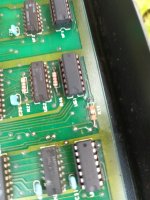Bagpuss
Member
Sorry my typo it's pin6. I put in a 74ls74 under the assumption that is was compatible with a 74s74 (i.e. it's the lower power version).
I'm going to get bmy desoldering gun out tomorrow and remove the sockets and check for shorts. I suspect I have a possible bridge under the socket.
I'm going to get bmy desoldering gun out tomorrow and remove the sockets and check for shorts. I suspect I have a possible bridge under the socket.

